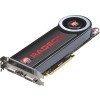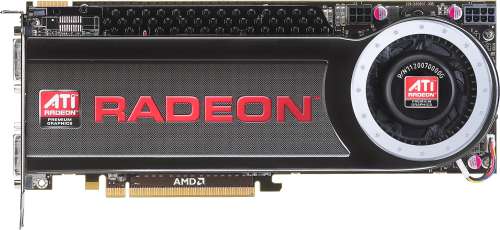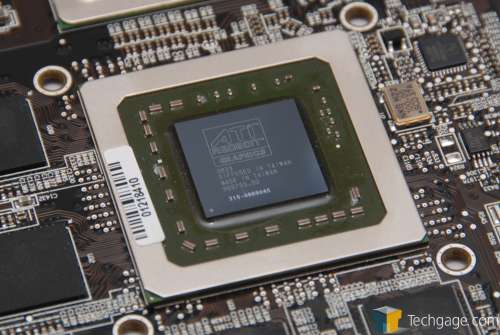- Qualcomm Launches Snapdragon 4 Gen 2 Mobile Platform
- AMD Launches Ryzen PRO 7000 Series Mobile & Desktop Platform
- Intel Launches Sleek Single-Slot Arc Pro A60 Workstation Graphics Card
- NVIDIA Announces Latest Ada Lovelace Additions: GeForce RTX 4060 Ti & RTX 4060
- Maxon Redshift With AMD Radeon GPU Rendering Support Now Available
Palit Radeon HD 4870 X2 1GB – AMD Reclaims GPU Supremacy

AMD has gone too long without a real high-end graphics card to compete with the competition, but they’re done with the pity, and prove it with the HD 4870 X2, which becomes the fastest graphics card the planet has ever seen. It may cost more than the competition, but its end performance easily negates that premium.
Page 1 – Introduction, Closer Look
Since ATI’s acquisition by AMD, it’s become ever-so-difficult to begin any sort of AMD-related article and not mention the trouble that the company has faced since. But there’s little point now – we all know about it, and know about it very well. So how about we start things off on a happier note this time? Sounds good.
AMD is now responsible for building the most powerful graphics card in the world.
How’s that? It all began with the launch of the Radeon HD 4850 and HD 4870 cards, which took even NVIDIA by surprise. Those cards were the first launch from the ATI camp that offered consumers a real choice when on the lookout for a new GPU. Unlike the HD 3000-series, which could never keep up to NVIDIA’s comparative offerings, the HD 4000-series out-performed them in many regards.
It’s good to see, because if there’s a company that needs some uplifting, it’s AMD. But with their HD 4000-series launch as successful as it was, we all knew what was next: Dual-GPU models. When the HD 3870 X2 came launched this past January, AMD became a real threat to NVIDIA, because despite the dual-GPU likeness, the card managed to outperform any one of NVIDIA’s single-GPU offerings, but that wasn’t too surprising given the design.
But with their HD 4000-series keeping up to and sometimes surpassing NVIDIA’s equal offerings, what could possibly be in store with a dual-GPU model of the HD 4870? How would it compare to NVIDIA’s GTX 280? Those questions will be answered today, and the results are sure to please.
Closer Look at the Radeon HD 4870 X2
Like the HD 3870 X2 before it, the HD 4870 X2 offers nothing more than the single-GPU version of the card, except twice of everything. It’s essentially two HD 4870 GPU cores placed on the same card, with various improvements to offer up to a 100% improvement in performance, which as we will find out is nice, since the SRP of the card is lower than purchasing two HD 4870s separately, in most cases.

The HD 4870 by itself was a mind-blowing card, offering a staggering 800 stream processors, 1.2 TeraFLOPS worth of horsepower, and the X2 version of the card essentially doubles those numbers to offer 1600 stream processors and 2.4 teraFLOPS worth of computational power. That metric by itself puts the HD 4870 X2 in another league compared to NVIDIA’s GTX 280, which offers close to 1 TeraFLOP of power.
|
Model
|
Core MHz
|
Mem MHz
|
Memory
|
Bus Width
|
Stream Proc.
|
| HD 4870 X2 |
750
|
900
|
2x1024MB
|
256-bit
|
1600
|
| HD 4870 |
750
|
900
|
512MB
|
256-bit
|
800
|
| HD 4850 |
625
|
993
|
512MB
|
256-bit
|
800
|
| HD 3870 X2 |
825
|
900
|
2x512MB
|
256-bit
|
320
|
| HD 3850 X2 |
666
|
828
|
2x512MB
|
256-bit
|
320
|
| HD 3870 |
775
|
900
|
512MB
|
256-bit
|
320
|
| HD 3850 |
666
|
828
|
512MB
|
256-bit
|
320
|
| HD 3650 |
725
|
800
|
256,512MB
|
128-bit
|
120
|
| HD 3450 |
600
|
500
|
256MB
|
64-bit
|
40
|
The basic improvements of the HD 4000-series includes PCI-E 2.0 and DX10.1 support, the option for Quad-GPU via CrossfireX along with enhanced anti-aliasing and anisotropic filtering methods, including the option to use up to 24x CFAA (custom filter AA). Given that these cards can power most any game with maxed out graphics, it’s the AA where they may make the most noticeable difference.
As mentioned above, the new card essentially doubles the available stream processors, so this card can go well beyond the general task of gaming and handle hardcore computational scenarios where a lot of horsepower is a requirement.
Straight from AMD, here is a chart explaining the differences between the X2 card and their already-launched HD 4870 and HD 4850:
|
Radeon HD 4870 X2
|
Radeon HD 4870
|
Radeon HD 4850
|
|
| Transistors |
~ 1.9 billion
|
965 million
|
965 million
|
| Manufacturing Process |
55nm
|
55nm
|
55nm
|
| Stream Processors |
1600
|
800
|
800
|
| Texture Units |
32
|
16
|
16
|
| Core Clock |
750 MHz
|
750 MHz
|
625 MHz
|
| Mem Data Rate |
3.6 Gbps
|
3.6 Gbps
|
2.0 Gpbs
|
| Math Processing |
> 2.4 TeraFLOPS
|
1.2 TeraFLOPS
|
1.0 TeraFLOPS
|
| DX 10.1 Support |
Yes
|
Yes
|
Yes
|
| Tessellation Unit |
Yes
|
Yes
|
Yes
|
| UVD |
Yes
|
Yes
|
Yes
|
| ATI PowerPlay |
Yes
|
Yes
|
Yes
|
Here we can see that the SRP for the HD 4870 X2 is $549, which equates to about $100 more than its main competitor, the GTX 280.
That’s not a small premium, as $450 is high to begin with. But bear in mind, when the GTX 280 was first launched, a little over a month ago, it retailed for $649, so it itself has dropped considerably due to the intense competition. As you’ll see in this article though, the HD 4870 X2 actually warrants itself the $100 premium. If your computer is prone to bleeding, this card shouldn’t be installed.
 HD 4870 X2 die shot |
Bad humor aside, as I mentioned in our review of Palit’s GTX 280 card, these new high-end GPUs are not for the weak of heart. In that article, I said that for the GTX 280 to be worthy of a purchase, you either have to own a 30″ monitor capable of a 2560×1600 resolution, or plan to use intense AA modes at the same or lower resolutions. Forget it if you are running anything less than 1920×1200… the GTX 280 and HD 4870 X2 is going to be overkill, and you will not likely see a real-world difference over a 9800 GTX/+ or HD 4870 unless running a DX10-heavy game.
It’s the higher resolutions and higher AA settings that sets both dual-GPU setups and massive GPU cores apart. They thrive on these insane settings, and it’s very rare that lower resolutions will show a worthy increase, and if it does, chances are the human eye wouldn’t be able to differentiate the differences between the two.
The GTX 280 effectively became the first card to be catered towards those with an insatiable need for the highest settings their game can offer, and ATI’s Radeon HD 4870 X2 takes it all one step further. But before we hop into testing, let’s first tackle our testing methodologies, which I highly recommend reading through if you haven’t before.
Support our efforts! With ad revenue at an all-time low for written websites, we're relying more than ever on reader support to help us continue putting so much effort into this type of content. You can support us by becoming a Patron, or by using our Amazon shopping affiliate links listed through our articles. Thanks for your support!





